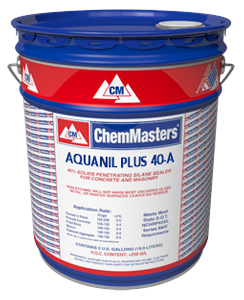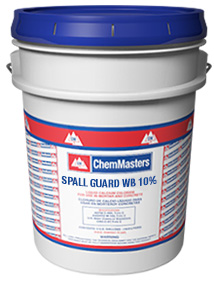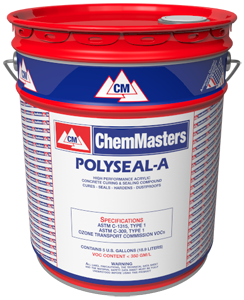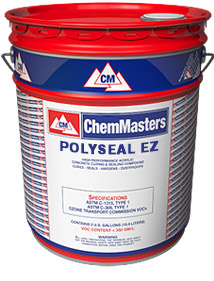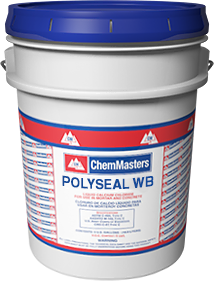Seal the Deal is intended to be an informative and educational publication for ChemMasters’ network of independent manufacturer’s representatives, distributors and contractors. We don’t want to make you chemical engineers, but we do want to help you feel better informed and more comfortable discussing construction chemicals. If there are specific products or topics you would like to see addressed in a future issue, please contact
John Fauth.
Is it a Sealer or Water Repellant?
Like most markets, the concrete industry has developed its own terminology, some of which can be contradictory and confusing. Many terms are subject to certain industry specifications, such as concrete cures (ASTM C 309) that clearly define what they are. But other terms are less
clearly defined and open to individual interpretation.
This is particularly true amongst the category of penetrating products which are often referred to as penetrating “sealers”. There isn’t an ASTM performance specification that defines what a product must do in order to be called a sealer. As a result, many different types of
chemistries are frequently referred to as “sealers“.
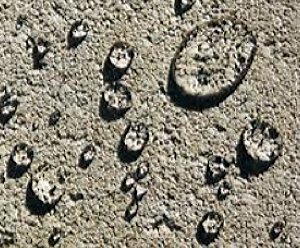
Water repellants are effective at preventing the absorption of water.
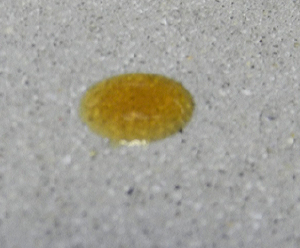
Oils, greases and other household and environmental contaminants can stain unsealed concrete.
What does it mean to seal concrete? There isn’t a uniformity of opinion about that. Most would agree that concrete must not absorb water in order to be considered “sealed”. But what about other liquids? A water repellant surface might still absorb solvents, greases and oils. A
water repellant surface might still be stained by food, beverages, fertilizers, etc. Would you expect a concrete sealer to provide protection from staining, or absorption of liquids that aren’t water based?
If your answer is no, then lots of chemistries qualify as sealers, including many penetrating products (those that leave no surface film) based upon silicates, silicones, silanes, siloxanes, linseed oil, etc. But if you expect a concrete sealer to do more than prevent water
absorption, then you’ve made a distinction between penetrating water repellants and film forming sealers. If that’s the case, all film forming sealers are also water repellants but not all penetrating water repellants are sealers.
Over the years, the terms “sealer” and “water repellant” have been used interchangeably. The accuracy of that comparison will depend entirely upon your expectations of what protection a sealer should do. Penetrating chemistries can have very attractive qualities. As water
repellants they can provide long lasting, highly effective protection against freeze/thaw damage and chloride ion absorption. But without a film forming component, penetrating water repellants do not offer protection against a wide array of common household and environmental
contaminants. For additional protection from staining and solvent based contaminants, use a film forming sealer.
Understanding these terms and how they impact product performance is the first step to choosing a product that meets your needs and expectations.
ChemMasters penetrating waterproofers include:
Low-VOC, Solvent Based, Penetrating Silane Sealer for Concrete & Masonry
Aquanil Plus 40-A is a penetrating, chemically reactive alkyltrialkoxy, 40% solids, solvent based silane sealer that repels moisture and water from concrete and masonry.
Penetrating Silane Sealer for Concrete and Masonry
Aquanil Plus 100 is a penetrating, chemically reactive alkyltrialkoxysilane ›95% solids, solvent based silane sealer that repels moisture and water from concrete and masonry.
Penetrating Siloxane Low-VOC Water-Based Concrete Sealer & Waterproofer
SpallGuard WB-10 a penetrating, chemically reactive, solvent-free, silane modifed siloxane emulsion designed to be a moisture and water repellent for concrete and masonry.
ChemMasters film forming sealers include:
Low-VOC Pure Acrylic Concrete Cure & Seal
Polyseal™ A is a high solids, high performance concrete curing and sealing compound. This state-of-the-art proprietary formulation completely resists discoloration from ultraviolet light exposure, creating a glossy membrane which remains clear throughout its service life.
Bubble Resistant Low-VOC Cure and Seal
Polyseal EZ is a proprietary formulation that resists bubble formation, cobwebbing, and stringing commonly associated with low-VOC cure and seals.
Low-VOC Solvent-Based Methyl-Methacrylate Concrete Sealer
Traz 25-A is a film forming sealer for concrete
and masonry. Traz 25-A is formulated with methyl
methacrylate polymers that develop high
gloss and are more chemical resistant than standard
acrylic sealers.
Pure Acrylic Non-Yellowing Cure and Seal
Polyseal WB is a high solids, water-based, non yellowing, acrylic concrete curing and sealing compound. This state-of-the-art proprietary formulation forms a tough acrylic film to effectively cure fresh concrete and protect older concrete.
Seal the Deal is intended to be an informative and educational publication for ChemMasters’ network of independent manufacturer’s representatives, distributors and contractors. We don’t want to make you chemical engineers, but we do want to help you feel better informed and more comfortable discussing construction chemicals. If there are specific products or topics you would like to see addressed in a future issue, please contact
John Fauth.

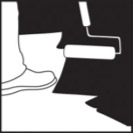 Seal the Deal
Seal the Deal

